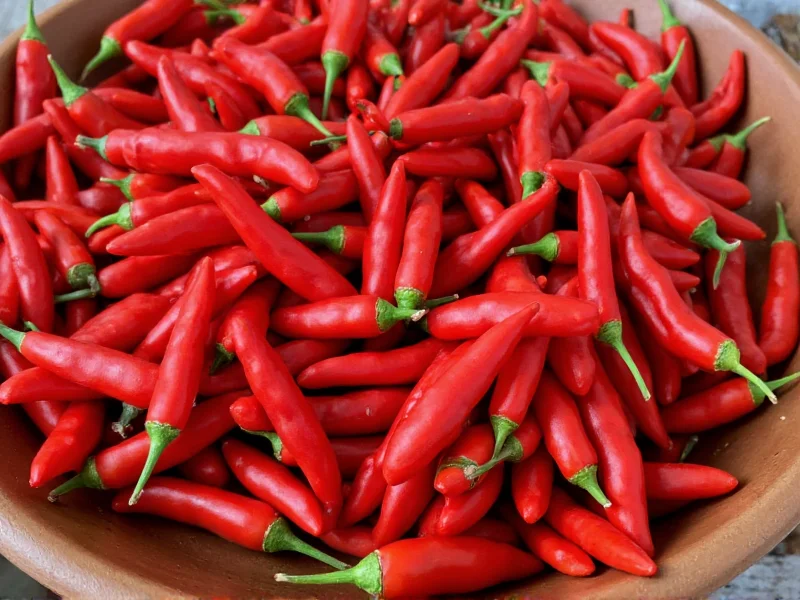When exploring small red chilis, understanding their specific characteristics helps maximize culinary potential. These compact powerhouses deliver more than just heat—they contribute complex flavor dimensions that transform dishes. Let's examine the most common varieties, their unique properties, and how to use them effectively in your cooking.
Common Small Red Chili Varieties Compared
| Chili Variety | Size (inches) | Scoville Range | Flavor Profile | Common Culinary Uses |
|---|---|---|---|---|
| Thai Bird's Eye | 1-2 | 50,000-100,000 | Grassy, citrusy, floral | Thai curries, Vietnamese dipping sauces, Filipino adobo |
| Pequín | 0.5-1 | 30,000-60,000 | Smoky, nutty, complex | Mexican salsas, mole sauces, pickled preparations |
| Cayenne (small varieties) | 2-5 | 30,000-50,000 | Sharp, bright, slightly sweet | Cajun dishes, hot sauces, spice blends |
| Fresno | 2-3 | 2,500-10,000 | Fruity, tangy, moderate heat | Salsas, roasted pepper dishes, stuffed peppers |
Understanding Heat Levels and Flavor Profiles
While all small red chilis deliver significant heat, their flavor profiles vary considerably. Thai bird's eye chilis provide an immediate, sharp heat with subtle citrus notes that work beautifully in Southeast Asian dishes. Pequín peppers offer a more complex experience—initial heat followed by smoky, nutty undertones that develop as you eat.
When selecting small red chilis for your recipes, consider both heat tolerance and flavor compatibility. The heat intensity of small red chili pepper varieties can vary based on growing conditions, with stressors like limited water often increasing capsaicin production. For consistent results in home cooking with small red chilis, taste a small piece before adding to your dish.
Culinary Applications and Pairing Suggestions
Small red chilis excel in applications where concentrated heat and flavor are needed without overwhelming other ingredients. Their compact size makes them ideal for:
- Infused oils: Create small batch chili oil by gently heating dried pequín peppers in neutral oil
- Fermented hot sauces: Thai bird's eye chilis produce vibrant, complex fermented sauces
- Garnishes: Thinly sliced fresh chilis add color and controlled heat to finished dishes
- Preserved preparations: Pickled pequín peppers maintain crunch while mellowing heat
When working with small red chilis in cooking, remember that heat distribution varies. Thai chilis concentrate capsaicin in the placenta and seeds, while pequín peppers distribute heat more evenly throughout the flesh. For small red chili substitution options, consider these pairings:
- Thai bird's eye → serrano peppers (use 2:1 ratio)
- Pequín → crushed red pepper flakes (use sparingly)
- Fresno → jalapeño (for milder applications)
Growing and Selecting Quality Small Red Chilis
Gardeners interested in cultivating small red chili varieties should note these peppers thrive in warm climates with well-draining soil. Most small red chili plant varieties require 70-90 days to mature from transplant. When selecting fresh small red chilis at the market, look for firm, glossy specimens without wrinkles or soft spots.
For gardeners in cooler climates, container growing works well for small red chili pepper plants. These compact varieties adapt well to pots with adequate sunlight. Harvest peppers when fully red for maximum heat and flavor development, though some cuisines use them at the green stage for different flavor profiles.
Storage and Safety Considerations
Proper storage extends the shelf life of small red chilis significantly. Fresh peppers last 2-3 weeks in the refrigerator's crisper drawer. For longer preservation, consider these methods:
- Drying: String fresh chilis and hang in a warm, dry place; store dried chilis in airtight containers
- Freezing: Freeze whole or chopped chilis in freezer bags for up to 6 months
- Vinegar preservation: Create small batch pickled chilis for refrigerator storage
When handling extremely hot small red chili varieties, wear gloves to prevent skin irritation. Avoid touching your face, especially eyes, after handling. If experiencing discomfort, dairy products like milk or yogurt help neutralize capsaicin better than water.
FAQs About Small Red Chilis
What's the difference between Thai bird's eye chilis and pequín peppers?
Thai bird's eye chilis are longer (1-2 inches) with grassy, citrus notes and higher heat (50,000-100,000 SHU), while pequín peppers are smaller (0.5-1 inch), rounder, with smoky, nutty flavors and slightly less heat (30,000-60,000 SHU). Pequíns grow pointing upward on the plant, whereas Thai chilis hang downward.
Can I substitute small red chilis in recipes that call for specific varieties?
Yes, but adjust quantities based on heat differences. For Thai bird's eye chilis, use half the amount of serrano peppers. For pequín peppers, substitute crushed red pepper flakes at 1:4 ratio. Always taste as you go when substituting small red chili pepper varieties to control heat levels.
How do I reduce the heat of small red chilis in a dish?
Remove seeds and white membranes where most capsaicin concentrates. Add dairy (yogurt, sour cream), acidic components (lime juice), or sweetness (honey, sugar) to balance heat. For small red chilis in cooking, remember that heat intensifies over time, so add them later in the cooking process for milder results.
Are small red chilis healthy?
Yes, small red chilis contain capsaicin which may boost metabolism and provide anti-inflammatory benefits. They're rich in vitamins A and C, plus antioxidants. When incorporating small red chili varieties into your diet, start with small amounts to assess tolerance, as excessive consumption can cause digestive discomfort for some individuals.











 浙公网安备
33010002000092号
浙公网安备
33010002000092号 浙B2-20120091-4
浙B2-20120091-4